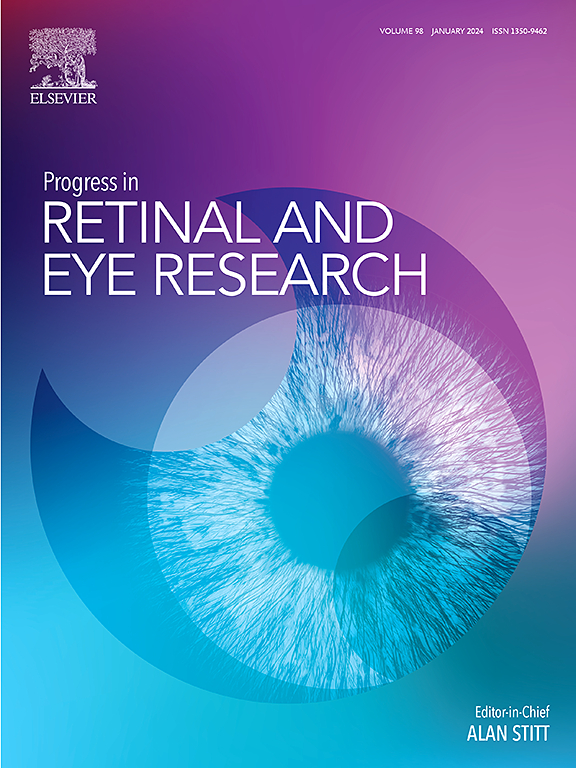先天性白内障的遗传结构:致病变异与形态学和临床结果的相关性。
IF 14.7
1区 医学
Q1 OPHTHALMOLOGY
引用次数: 0
摘要
先天性白内障(Congenital cataract, CC)是指出生时晶状体混浊,对儿童早期视力发育和终身视力损害构成相当大的挑战。尽管很大一部分CC病例是由遗传缺陷引起的,但在了解基因型-表型相关性以及与此相关的潜在致病变异的特征方面仍存在重大差距。在目前的研究中,通过比较文献综述来自Cat-map和HGMD的39个已知CC相关基因,在150个CC家族的内部队列中,通过比较10530个不同眼病家族的内部外显子组测序数据以及gnomAD数据库的数据,研究了CC的遗传结构。对比分析表明:1)内部遗传诊断率为63.3% (95/150);2)特定基因的变异与不同的表型相关,特别是BFSP2、MIP、GJA3、PITX3和CRYGD的变异;3) GJA3变异常与高度近视相关,CRYGC变异常与小角膜或小眼相关;4) CRYAA、LIM2和MIP变异主要涉及精氨酸到半胱氨酸的变化,CRYGD变异主要涉及脯氨酸到苏氨酸的变化;5)变异致病性的解释是一个巨大的挑战。不确定的CC变异存在于高达56.0%的普通人群中。总之,确定的单基因变异贡献了大约三分之二的CC,这在以前被低估为三分之一。这些发现拓宽了目前对CC基因型-表型关系的理解,并强调了精确的遗传分类对有效诊断和管理的重要性。进一步探索这些遗传因素可能为CC的预防和治疗策略提供新的见解。本文章由计算机程序翻译,如有差异,请以英文原文为准。
Genetic architecture of congenital cataracts: correlation of pathogenic variants with morphology and clinical outcomes
Congenital cataract (CC) refers to lens opacity presented at birth, posing considerable challenges to early childhood visual development and lifelong visual impairment. Although a substantial proportion of CC cases arise from genetic defects, significant gaps remain in the understanding of the genotype-phenotype correlations and the characteristics of potentially pathogenic variants associated with this condition. In the current study, the genetic architecture of CC was investigated by a comparative literature review of 39 known CC-associated genes from Cat-map and HGMD, within an in-house cohort of 150 CC families, complemented by comparing with in-house exome sequencing data from 10,530 families with various eye conditions as well as data from the gnomAD database. Comparative analysis revealed: 1) The in-house genetic diagnostic yield was 63.3% (95/150); 2) Variants in specific genes were correlated with distinct phenotypes, especially for variants in BFSP2, MIP, GJA3, PITX3 and CRYGD; 3) GJA3 variants were often associated with high myopia, and CRYGC variants were often linked to microcornea or microphthalmia; 4) A predominance of CRYAA, LIM2 and MIP variants involve arginine to cysteine changes, and CRYGD variants involve proline to threonine changes; 5) The interpretation of variant pathogenicity is a great challenge. Uncertain variants in CC are present in up to 56.0% of the general population. In conclusion, identified monogenic variants contribute to approximately two-thirds of CC, which has been underestimated as one-third before. These findings broaden the current understanding of the genotype-phenotype relationships in CC and underscore the importance of precise genetic classification for effective diagnosis and management. Further exploration of these genetic factors may provide new insights into prevention and treatment strategies for CC.
求助全文
通过发布文献求助,成功后即可免费获取论文全文。
去求助
来源期刊
CiteScore
34.10
自引率
5.10%
发文量
78
期刊介绍:
Progress in Retinal and Eye Research is a Reviews-only journal. By invitation, leading experts write on basic and clinical aspects of the eye in a style appealing to molecular biologists, neuroscientists and physiologists, as well as to vision researchers and ophthalmologists.
The journal covers all aspects of eye research, including topics pertaining to the retina and pigment epithelial layer, cornea, tears, lacrimal glands, aqueous humour, iris, ciliary body, trabeculum, lens, vitreous humour and diseases such as dry-eye, inflammation, keratoconus, corneal dystrophy, glaucoma and cataract.

 求助内容:
求助内容: 应助结果提醒方式:
应助结果提醒方式:


